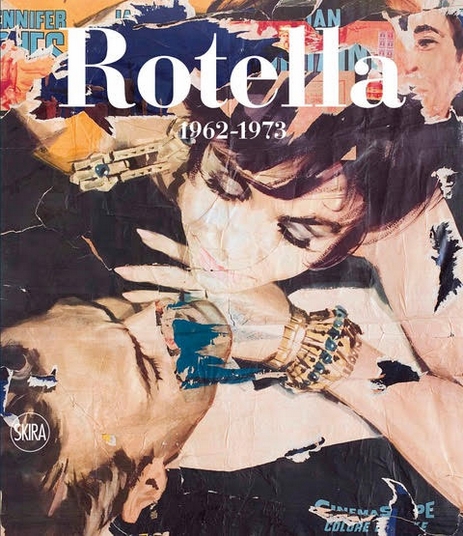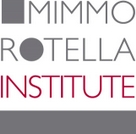Main menu:
ACTIVITIES > CATALOGUE RAISONNÉ

MIMMO ROTELLA
Catalogue raisonné. Volume Two 1962 - 1973
Publisher: Skira
Dual-languange edition (Italian - English)
Year: 2020
ISBN: 978-88-572-4270-5
Dimensions: 24 x 28 cm
The second volume of the Catalogue raisonné of the works works of Mimmo Rotella (Catanzaro, 1918 – Milan, 2006), edited by Germano Celant, is part of a more extensive systematic cataloguing project of his entire oeuvre.
The publication is being developed in partnership with the Mimmo Rotella Institute – established by Inna and Aghnessa Rotella in 2012 and directed by Antonella Soldaini – and the Fondazione Mimmo Rotella, headed by Aghnessa Rotella.
In this volume, the scholarly analysis and verification are carried out on works made between 1962 and 1973, when Rotella consolidated his décollage practice in its most graphic and pop aspects and began exploring photomechanical image reproduction techniques. He used photo emulsion on canvas and the artypo, up to defining a more automatic and immediate process in his effaçages and frottages. Across a chronological development, the Catalogue highlights the various stages that have distinguished his practice, thus allowing an inclusive and documented reading of this period. Starting from advertising images regarding cinema or products of mass consumption, Rotella continued with his experiments on décollage, now no longer Informel but rather influenced by new icons of mass society. The works made in the early 1960s were shown at important international events attentive to the most innovative contemporary trends, including “New Realists” (New York, Sidney Janis Gallery, 1962) and the 32. Venice Biennale in 1964. At both, Rotella’s works were compared to Pop Art, especially from the US, which draws upon an imagery more akin to the Italian artist’s. His interest in the printing process also grew at this time: this gave life to his first photo emulsions on canvas – obtained by projecting the selected image on primed canvas – and then the artypos. The latter are large sheets of paper used to calibrate the printing machines and then normally discarded, of which Rotella appropriates to make artworks characterized by casual image overlappings. In line with the libertarian and licentious principles of the 1968 movement, the artist focused on glossy magazines for details, often laden with powerful eroticism, for his effaçages and frottages, resulting from the use of solvent on newspaper cut-outs.“The marriage of photography and art was crucial in the 1960s, when artists broke with the idea of a linguistic specific and took up the notions of expansion that were already evident from Futurism to Dadaism and Surrealism. Rotella also discovered photography as a visual tool and, aware of the traps of Expressionism that in the 1950s had mixed colour with the reproduced image, sought to utilize photographic images in a completely ‘self-referential’ way [...]. He tried to communicate through photography’s pure informative specificity, reducing the artistic transposition to a minimum” (Celant).
Germano Celant is internationally known for his theories on Arte Povera. He has also authored over 100 publications, including books and catalogues, and has curated hundreds of exhibitions in the most prestigious museums and institutions around the world. He was Contributing Editor for the magazine Artforum, New York, and since 1991 for Interview Magazine, New York; from 1999 to 2018 he directed the art column for the weekly L’Espresso, Rome; since 2000 he has collaborated with the monthly design magazine Interni, Milan. In 1987 he won the Frank Jewett Mather Award for his activity as an art critic; in 2004 he was given a Laurea honoris causa in Architecture from the Università degli Studi di Genova, School of Architecture; finally, in 2013 he received The Agnes Gund Curatorial Award on behalf of the Independent Curators International, New York. From 1989 to 2008 he was Senior Curator of Contemporary Art at the Solomon R. Guggenheim Museum in New York; from 1995 to 2014 he was Director and, since 2015, Artistic and Scientific Superintendent of the Fondazione Prada; in 1997 he was Director of the 47. Venice Biennale; in 2004 he was Artistic Supervisor in planning 100 cultural events for “Genova 2004, Capitale Europea della Cultura”; since 2005 he is Curator at the Fondazione Aldo Rossi, Milan, and since 2008 he is Artistic and Scientific Curator for the Fondazione Annabianca e Emilio Vedova, Venice. From 2009 to 2011 he was the scientific supervisor for Art and Architecture at the Milan Triennale. He curated the exhibition “Arts & Foods. Rituali dal 1851”, Padiglione d’Arte di Expo 2015, at the Milan Triennale. In 2016 he was Project Director of “The Floating Piers”, a work by Christo and Jeanne-Claude at Lake Iseo. In 2018 he curated the shows “Post Zang Tumb Tuuum. Art Life Politics: Italia 1918-1943” at the Fondazione Prada, Milan, and “Mimmo Rotella Manifesto”at the Galleria Nazionale d’Arte Moderna e Contemporanea, Rome.

